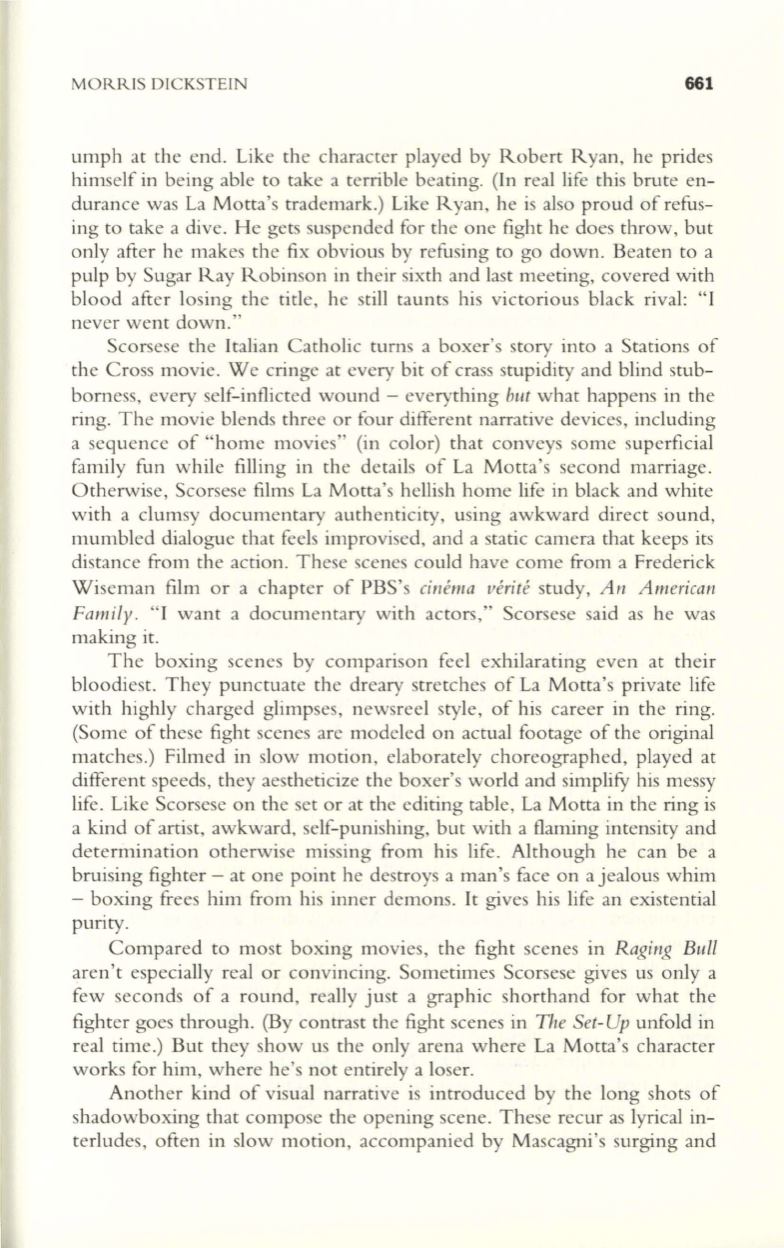
MORRIS DICKSTEIN
661
umph at the end. Like the character played by Robert Ryan, he prides
himself in being able to take a terrible beating. (In real life this brute en–
durance was La Motta's trademark.) Like Ryan, he is also proud of refus–
ing to take a dive. He gets suspended for the one fight he does throw, but
only after he makes the fix obv ious by refusing
to
go down. Beaten to a
pulp by Sugar Ray Robinson in their sixth and last meeting, covered with
blood after losing the title, he still taunts his victorious black rival: " I
never went down."
Scorsese the Italian Catholic turns a boxer's story into a Stations of
the Cross movie. We cringe at every bit of crass stupidity and blind stub–
borness, every self-inflicted wound - everything
but
what happens in the
ring. The movie blends three or four different narrative devices, including
a sequence of "home movies" (in color) that conveys some superficial
family fun while filling in the details of La Motta's second marriage.
Otherwise, Scorsese films La Motta's hellish home life in black and white
with a clumsy documentary authenticity, using awkward direct sound,
mumbled dialogue that feels improvised, and a static camera that keeps its
distance from the action. These scenes could have come from a Frederick
Wiseman film or a chapter of PBS's
cinema verite
study,
An American
Family.
" I want a documentary with actors," Scorsese said as he was
making it.
The boxing scenes by comparison feel exhilarating even at their
bloodiest. They punctuate the dreary stretches of La Motta's private life
with highly charged glimpses, newsreel style, of his career in the ring.
(Some of these fight scenes are modeled on actual footage of the original
matches.) Filmed in slow motion, elaborately choreographed, played at
different speeds, they ae theticize the boxer's world and simplify his messy
life. Like Scorsese on the set or at the editing table, La Motta in the ring is
a kind of artist, awkward, self-punishing, but with a flaming intensity and
determination otherwise missing from his life. Although he can be a
bruising fighter - at one point he destroys a man's face on a jealous whim
- boxing frees him from his inner demons. It gives his life an existential
purity.
Compared
to
most boxing movies, the fight scenes in
Raging Bull
aren't especially real or convincing. Sometimes Scorsese gives us only a
few seconds of a round, really just a graphic shorthand for what the
fighter goes through. (By contrast the fight scenes in
The
Set-Up
unfold in
real time.) But they show us the only arena where La Motta's character
works for him, where he's not entirely a loser.
Another kind of visual narrative is introduced by the long shots of
shadowboxing that compose the opening scene. These recur as lyrical in–
terludes, often in slow motion, accompanied by Mascagni's surging and


